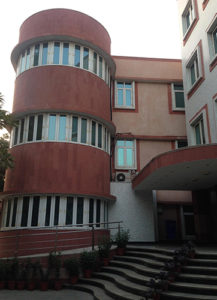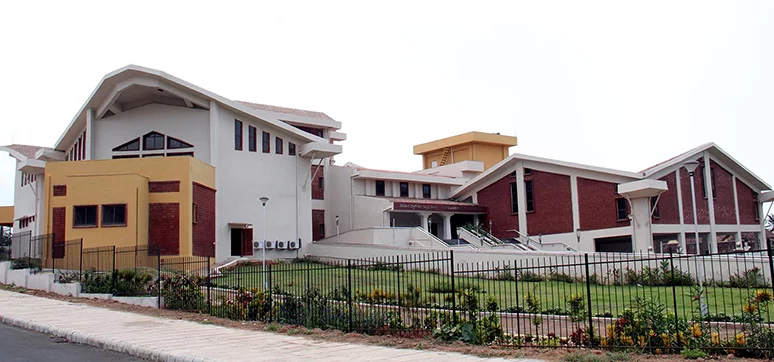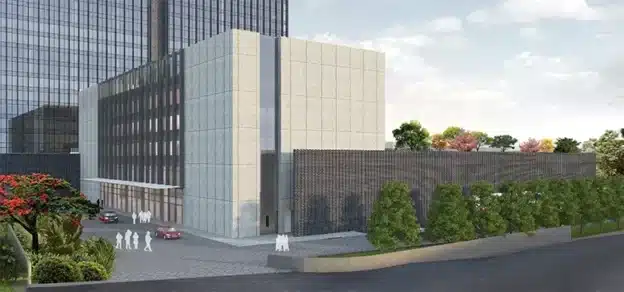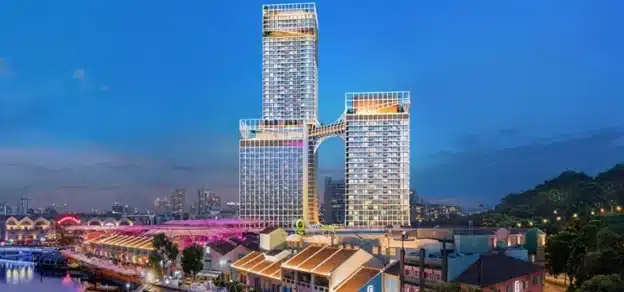In the contemporary architectural scenario, with the easy availability of large format structural glass, the tendency of indiscriminate use of glass as an external façade material, with no proper material audit and decision making, has resulted in poorly functioning buildings with huge energy demands and carbon footprint. In the present context, understanding the process involved in auditing a strategy for combining glass and natural building materials is of paramount importance.

The parameters one may use to audit the use of natural materials with glass fall under some broad categories: –
• Energy conservation
• Cost-effectiveness
• Aesthetics
• Building typology
• Site context and vernacular
• Façades and human behaviour
Energy Conservation
The plaster has a thermal conductivity of 0.18 W/Mk. Brick has a thermal conductivity of around 0.77 W/Mk. Normal window glass has a thermal conductivity of around 0.80 W/Mk and natural stone has a thermal conductivity of around 1.6 to 3.5 W/Mk. However, the flow of heat also depends on the thickness of the material, inside and outside temperature differences and air gap or cavity between the materials and also the quality of the materials used. For example, thicker wall thickness or thicker glass pane, use of double glass unit and cavity wall construction, the quality of clay used in brickwork can alter the thermal conductivity and UV coatings on the glass surface can reduce the thermal conductivity to a great extent.

Standard brick masonry with a plastered surface has a lower thermal conductivity than a normal 5 mm thick glass window (Although this factor cannot be the only criterion for the choice to determine the extent of the use of glass on an external surface). It is imperative to use 12 to 15% of the external wall’s area of any habitable space to be left for glass windows for natural lighting and ventilation as per norms.
However, heat gain due to the greenhouse effect of glass surface (heat transferred through glass) tends not to be dissipated back to the atmosphere which is not the case in brick walls with plaster. The use of solar control glass is advantageous compared to conventional building materials in terms of heat reflectivity, absorbance and transmittance. Solar control glass is developed to allow sunlight to pass through a window or façade whilst radiating and reflecting away a large degree of the sun’s heat. The indoor space stays brighter and much cooler than those where normal glass is used.
Solar control is a key issue in terms of energy saving. In hot conditions, or for buildings with high internal loads, it is used to minimise solar heat gain by rejecting solar radiation and helping control glare. In more temperate conditions, it can be used to achieve high levels of natural light. Solar control glass panels used for large format structural glazing walls also have an easier maintainability factor when compared to natural building materials like brick, plastered or stone surfaces, primarily because of the seamless nature of the material, and because of the use of a dual-action self-cleaning coating located on the external glass pane.
Cost Effectiveness
The cost of full brick masonry is around Rs 2000/sq m. The cost of a 5mm thick glass window with an aluminium frame is around Rs 3000/sq m, and full random rubble masonry is around Rs 2600/sq m. However, special solar control glass panels like opal glass, super silver glass, Eco sense glass and sun shield glass are comparatively much more expensive. Prices of structural glazing walls, including the necessary framework, range from Rs 4000/sq m to Rs 6000 /sq m. Hence, although glass is more expensive than brickwork, the use of glass is essential for natural lighting and ventilation and masonry work. So glass needs to be synchronised harmoniously to increase the energy efficiency of the building, and at the same time avoid undesirable increases in heat load.

Another important factor to be taken into account whilst deciding the choice and integration of external materials is the process of Life Cycle Cost Analysis. This is an audit of the choice of materials in view of their initial cost, procurement ease, initial price factor, installation and commissioning ease, operation maintenance and performance monitoring, ease of modification or up-gradation and decommissioning, and the replacement and recovery of materials.
Aesthetics
Installing reflective glass imparts a sharp, bold appearance to the exterior. Large seamless glass façades impart a ‘contemporary character to any building façade. With global reach and presence becoming an image/ branding requirement in business establishments all over the world, more and more multinational companies and other business houses are leaning towards the extensive use of glass façades in multistoried building blocks. Although one cannot deny the timeless aesthetic character of stone or exposed brick masonry, trends in past decades indicate a gradual shift towards glass and other surfaces like drywall and metallic cladding.
Building Typology

The integration of glass with conventional building materials must be determined according to the building typology. This is one factor that many architects and designers very often tend to ignore in their quest to create a façade design that is aesthetically pleasing. The requirement for natural lighting and ventilation varies considerably with the Internal usage and functions of Internal space planning.
Some internal spaces require abundant natural lighting; others require a moderate amount. Some spaces require only artificial lighting and do not require any natural lighting, which might hamper the proper functioning of the programmatic activities. Hence, it is always important to carefully choose and balance the proportional usage of glass and other materials for the eternal façade depending on the internal usage.
Site Context And Vernacular
The location of the building site with respect to the surrounding region is a very important factor when deciding the choice of natural materials to use with glass. It is always preferable to use natural materials with glass which are easily available, to minimise issues of maintenance and replaceability. The use of large quantities of glass and aluminium in inaccessible or remote regions is never a good idea unless one can find local glass manufacturers or dealerships. It is preferable to use locally available materials like brick, stone and wooden frames, and optimise the quantity of glass used.
In such areas, window designs should promote the use of smaller glass panels and segmentation of the window surface, to make replacement and repair easier, and also minimise the chances of breakage in long-distance transit. Ultimately, when combining natural materials with glass in remote areas, it’s important to remember that the vernacular character of such areas is retained by highlighting and utilising the indigenous character of that region.
Facades And Human Behavior

We design our building interiors and exteriors for our users, and building design shapes the behaviour of its users in the long run. It is the architect’s responsibility and endeavour to continuously and consciously try to improve the quality of life of the end-users of our buildings. When combining glazing with natural materials, one must be cognizant of how buildings are actually used, more than how they look in a computer rendering or photograph. For example, educational institution design often uses exposed brick combined with the strategic use of glass.
Conclusion
The building façade is a manifestation of the character, efficiency and longevity of the building, internally and externally. Hence, any good architecture must take into account all these aforementioned factors that contribute to the decisions one must make when creating a building façade, and choose the use of glass and natural materials accordingly.














